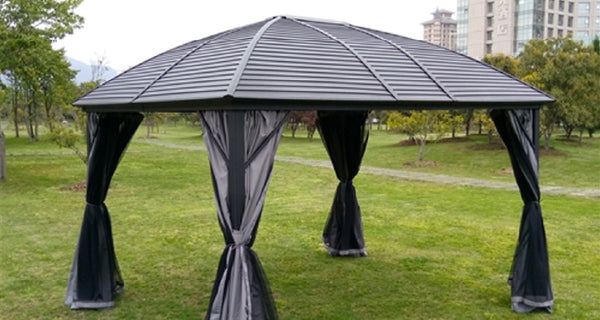Call Us: 1-833-742-7243
info@garagedepartment.com

A gazebo or a garden pavilion can revamp the look of a yard. A structure like this is an investment; it adds to the house's resale value and enhances the overall quality of life. Building a gazebo is an experience itself. It can be a good bonding activity with friends and family or something to enjoy solo. It requires proper planning to ensure the gazebo stays put for a long time. This article covers the process of building a gazebo step-by-step.
The placement of the pavilion or gazebo needs to be adequately evaluated to ensure the structure gets the right environment. The ideal locations for backyard installations are level and flat for drainage and optimum support. Avoid putting the gazebo or pavilion in low-lying yard sections where water can collect after bad weather conditions like heavy rain or thunderstorms.
Avoid constructing the pavilion or gazebo next to growing trees as they can grow and infringe upon the structure site. Consider the routes leading up to the gazebo or pavilion. The structure shouldn’t be near dangerous places like beehives or protruding tree stumps.
Choose an area consistent with the pavilion’s planned objective or gazebo. If socialising is the purpose, then It’s ideal to choose a centrally located zone so that more people can gather around to mix. Choose a more isolated area near bushes, trees or fencing for more privacy. It can be a peaceful haven for introspection and relaxation. Consider building the gazebo or pavilion closer to the house for quiet breakfast mornings or dinners in the garden. This will provide easy access to the house.

After finalizing the gazebo placement or pavilion, move on to measurements. It’s vital to measure the width and length of the yard to narrow down size preferences. Consider the height, too, as it will affect other structures or trees in the yard. Measure the space needed to walk around the gazebo or pavilion and the distance from the structure to other yard areas. After measuring the available area, it will be easier to narrow down size options for the gazebo or pavilion. Building a large structure that can be reasonably accommodated elevates the yard's look; it adds more value and has the potential to grow. A large structure can be used in multiple ways too.
Gazebos and garden pavilions are not permanent outdoor structures, so obtaining a building permit may not be necessary, but different places have different rules to check for building codes. There may be a limit on the size of the structure to be built on the yard, so check for that too. There may also be particular distance limitations for constructions from public roadways, powerlines, or other buildings, including the house. Other regulations may apply if the structure is attached to the building.
Houses in a housing complex or community require additional permission from the respective Homeowners’ Association before any new structure is constructed. Most Homeowners’ Associations restrict construction height to maintain the site lines of other homes in the neighbourhood.
There are rules about how close a structure can be erected to walls, other structures, or fences. The easiest method to get clearance for a gazebo or a garden pavilion is to describe the project thoroughly. Giving detailed information regarding the installation and its planned usage increases the chances of obtaining the necessary permissions.
Providing outlines and drawings of the construction with labelled dimensions and photographs of the desired site location may be applicable. It may also be helpful to map out the space for the new project using construction or garden stakes. This will help examine distances and site lines, as well as sun exposure and other aspects that may affect the project.

Proper site preparation ensures the longevity and stability of the gazebo or garden pavilion. The structure's kind and size determine the size preparation procedures. The company installing the gazebo or garden pavilion can prepare the site, or a contractor can do the job. However, depending on the size of the structure, some of the initial preparatory work can be done without the help of a contractor or company and helps save a substantial amount of money.
Site Preparation For Gazebos
Gazebos with built-in floors can be set on a pulverised stone pad or a concrete base.
A concrete base should be used for gazebos that do not have flooring.
Most pavilions may be installed on existing concrete slabs, but confirm with the company building the pavilion to ensure enough drainage for the gazebo to keep dry.
Concrete Slab Foundation
Pour the concrete pad at a 4” plus extra depth around the outside borders to get proper weight distribution and sturdiness. Call 811 for utility marking; it takes a few days, but it helps avoid fines from utility line damage.
Crushed Stone Pads
Crushed stone pads can be built on level structures measuring 4x6 or 4x4 pressure-treated timber. Put the lumber approximately 12” wider than the gazebo’s dimensions. The next step is to fill the frame with 4” to 6” of crushed stone or gravel.
The stone pad and the pad's design should be constructed to allow proper rainwater drainage. Any base structure needs to have adequate water drainage. The stone pad should support the gazebo while keeping the floor dry.

Pavilions do not have a foundation, so they must be attached to continuous post footings or a concrete base that sustains the pavilion.
Nationwide services like 811 can deploy local utility providers to identify the placement of any sewer, electrical or water lines before any digging. This process usually takes a few days to finish, so factor in this timeline.
Concrete Slab Foundation Of A Pavilion
Pavilions can be securely attached to a cemented concrete slab with a minimum of 4” in thickness and a total depth of 12” on the outside border. The anchor brackets must be fastened to the concrete slab foundation to place the support columns.
Concrete Footings
Concrete Footing is needed for installing a pavilion without a concrete slab foundation. Post holes are dug to hold the concrete footings. Footing is particularly essential for establishing a gazebo on an existing paver patio. Concrete footings must support all construction. The footer size varies based on the size unit. Preparing the foundations by oneself is not easy, but it is doable.
Refer to the diagram of the structure. Then drill post holes to an appropriate depth (at least six inches) beneath the frost line. Deep post holes prevent the pavilion from falling out because of de-freezing and refreezing. After this, the post holes need to be filled with concrete and rebarred. Ensure the concrete is cured correctly before installing the pavilion. Once the concrete footings are in place, the pavilion can be installed with the help of bolted-in anchor brackets.

A gazebo or a garden pavilion is a versatile structure, which can be used for multiple purposes like parties or for some quiet family time. Such outdoor structures have become quite popular over the years, for their unique appeal.
This article is a basic guide to building a gazebo or a garden pavilion. The best products for building a gazebo or garden pavilion can be found here. Garage Department not only provides top-notch products but also delivers products to your doorstep. Go ahead and build the yard structure you have been wanting to build for ages. Shop now!
For your next read: Ways To Spruce Up Your Deck